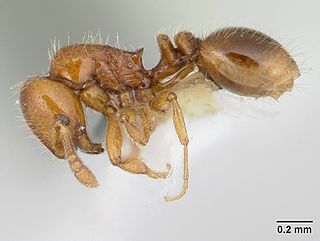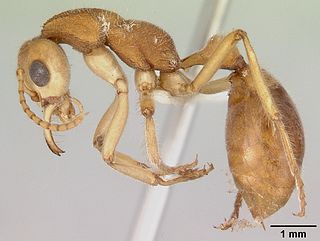
Tetramorium atratulum is a rare workerless socially parasitic ant from the Palaearctic region, which has even been introduced together with its host in North America. This extreme inquiline is represented only by female and pupoid type male individuals, whose morphology and anatomy indicate a highly specialized level of parasitism. The body of males is depigmentated, the cuticle is thin, the petiole and postpetiole are widely connected, and degenerate mandibles, palps, and antennae are observed. Female wing venation is reduced and the occipital region is narrowed. Mature females are typically physogastric and found in queenless host nests.

Myrmicinae is a subfamily of ants, with about 140 extant genera; their distribution is cosmopolitan. The pupae lack cocoons. Some species retain a functional sting. The petioles of Myrmicinae consist of two nodes. The nests are permanent and in soil, rotting wood, under stones, or in trees.

Oxyepoecus is a Neotropical genus of ant in the subfamily Myrmicinae. The genus is a member of the tribe Solenopsidini and currently includes 20 species.

Oxyepoecus inquilinus is species of ant in the genus Oxyepoecus. It is endemic to Argentina. The species is listed together with two other Oxyepoecus species as "Vulnerable D2" by IUCN.

Mycocepurus smithii is a species of fungus-growing ant from Latin America. This species is widely distributed geographically and can be found from Mexico in the north to Argentina in the south, as well as on some Caribbean Islands. It lives in a variety of forested habitats and associated open areas. Two studies published in 2009 demonstrated that some populations of the species consist exclusively of females which reproduce via thelytokous parthenogenesis. A detailed study found evidence of sexual reproduction in some populations in the Brazilian Amazon. Accordingly, M. smithii consists of a mosaic of sexually and asexually reproducing populations. In asexual populations all ants in a single colony are female clones of the queen. Inside the colony, the ants cultivate a garden of fungus grown with pieces of dead vegetable matter, dead insects, and insect droppings.

Ypresiomyrma is an extinct genus of ants in the subfamily Myrmeciinae that was described in 2006. There are four species described; one species is from the Isle of Fur in Denmark, two are from the McAbee Fossil Beds in British Columbia, Canada, and the fourth from the Bol’shaya Svetlovodnaya fossil site in Russia. The queens of this genus are large, the mandibles are elongated and the eyes are well developed; a stinger is also present. The behaviour of these ants would have been similar to that of extant Myrmeciinae ants, such as solitary foraging for arthropod prey and never leaving pheromone trails. The alates were poor flyers due to their size, and birds and animals most likely preyed on these ants. Ypresiomyrma is not assigned to any tribe, and is instead generally regarded as incertae sedis within Myrmeciinae. However, some authors believe Ypresiomyrma should be assigned as incertae sedis within Formicidae.

Prionomyrmecini is an ant tribe belonging to the subfamily Myrmeciinae established by William Morton Wheeler in 1915. Two members are a part of this tribe, the extant Nothomyrmecia and the extinct Prionomyrmex. The tribe was once considered a subfamily due to the similarities between Nothomyrmecia and Prionomyrmex, but such reclassification was not widely accepted by the scientific community. These ants can be identified by their long slender bodies, powerful stingers and elongated mandibles. Fossil Prionomyrmecini ants were once found throughout Europe, possibly nesting in trees and preferring jungle habitats. Today, Prionomyrmecini is only found in Australia, preferring old-growth mallee woodland surrounded by Eucalyptus trees. Nothomyrmecia workers feed on nectar and arthropods, using their compound eyes for prey and navigational purposes. Owing to their primitive nature, they do not recruit others to food sources or create pheromone trails. Nothomyrmecia colonies are small, consisting of 50 to 100 individuals.

Agroecomyrmecinae is a subfamily of ants containing two extant and two fossil genera. The subfamily was originally classified in 1930 by Carpenter as Agroecomyrmecini, a Myrmicinae tribe. Bolton raised the tribe to subfamily status in 2003, suggesting that Agroecomyrmecinae might be the sister taxon to Myrmicinae. It has since been discovered to be one of the earliest lineages of ants, a clade from the basal polytomy for all ants. In 2014, the subfamily was expanded to two tribes. The tribe Ankylomyrmini was moved from the subfamily Myrmicinae to Agroemyrmecinae.

Tatuidris, or armadillo ant, is a rare genus of ants consisting of a single species, Tatuidris tatusia. The ants are small in size and inhabit the leaf litter of Neotropical forests in Central and South America, from Mexico to Brazil. Workers are ferruginous-colored to dark red and present a distinctive morphology, consisting of a shield-like head with a broad vertex, ventrally-turned heavy mandibles which do not overlap at full closure, and unique among ants – an antenna socket apparatus sitting upside-down. Little is known about the biology of the ants, but they are likely nocturnal and specialist predators.

Tyrannomyrmex is a rare tropical genus of ants in the subfamily Myrmicinae. Three similar species, only known from workers, are recognized and share small eyes and edentate mandibles.

Megalomyrmex silvestrii is a Neotropical species of ants in the subfamily Myrmicinae. Megalomyrmex silvestrii is widespread in the mainland Neotropics from Mexico to northern Argentina. This species occurs in moist to wet forest habitats, from sea level to 1100 m elevation. It nests in small chambers in rotten wood or opportunistically in other small cavities in the soil. Colonies have been found in small attine nests and alone, suggesting it is a facultative predator of small Attini.
Sphinctomyrmex schoerederi is a Neotropical species of ants in the subfamily Dorylinae. S. schoerederi is known only from the holotype, collected in a leaf litter sample from a forest remnant in the campus of Universidade Federal de Viçosa in Brazil, where it occurs in sympatry with S. stali. Gynes and males are unknown.
Lenomyrmex inusitatus is a Neotropical species of ant in the subfamily Myrmicinae. The worker of Lenomyrmex inusitatus is distinguished from other Lenomyrmex workers by smooth and shiny mesosoma with well-developed propodeal spines and by the foveolate-striate sculpture covering all the dorsal surface of its head. L. inusitatus has an unusual distribution since it is the single Lenomyrmex species recorded east of the Andes.
Stenamma andersoni is a Neotropical species of ant in the subfamily Myrmicinae.

Slave-making ants are brood parasites that capture broods of other ant species to increase the worker force of their colony. After emerging in the slave-maker nest, slave workers work as if they were in their own colony, while parasite workers only concentrate on replenishing the labor force from neighboring host nests, a process called slave raiding.
Cyatta is a genus of ant in the subfamily Myrmicinae containing the single species Cyatta abscondita. It is considered the most recent ancestor of all fungus-farming ants and a living fossil.
Oxyepoecus bidentatus is a Neotropical species of ant in the genus Oxyepoecus. The species is only known from workers from Paraguay.

Novomessor albisetosus, also known as the desert harvester ant, is a species of ant found in the United States and Mexico. A member of the genus Novomessor in the subfamily Myrmicinae, it was first described by Austrian entomologist Gustav Mayr in 1886. It was originally placed in the genus Aphaenogaster, but a recent phylogenetic study concluded that it is genetically distinct and should be separated. It is a medium-sized species, measuring 6 to 8.5 millimeters and has a ferruginous body color. It can be distinguished from other Novomessor species by its shorter head and subparallel eyes.













